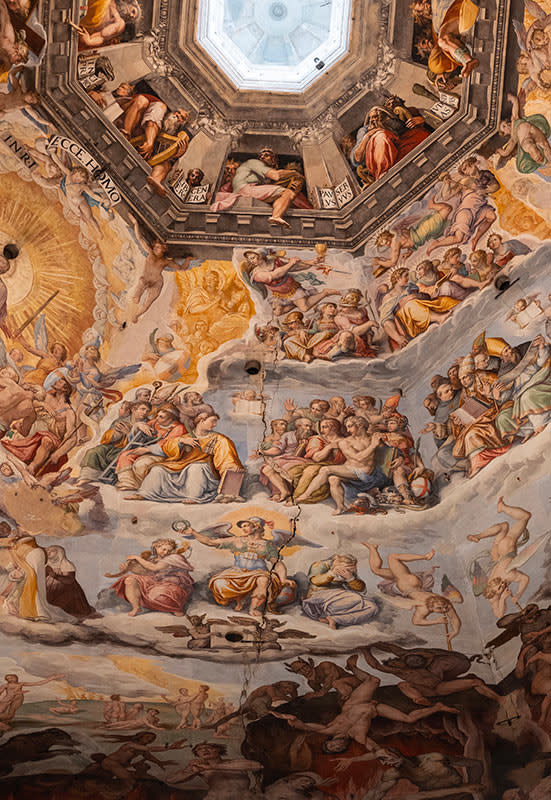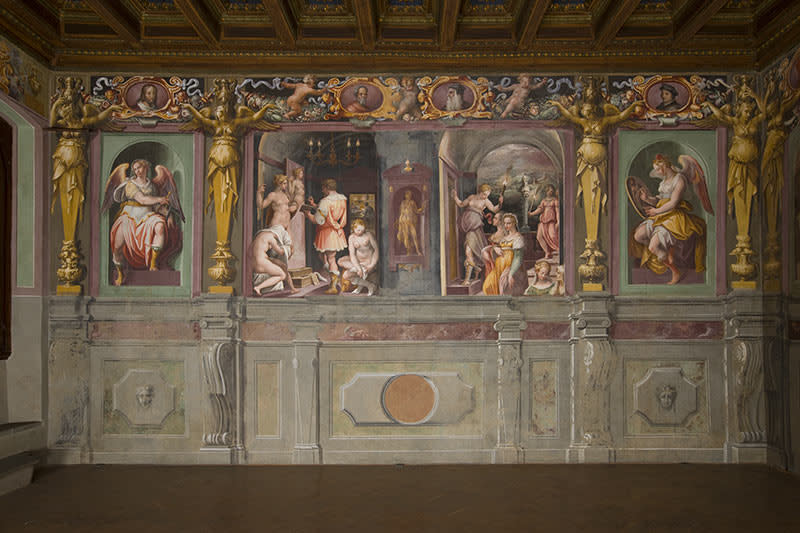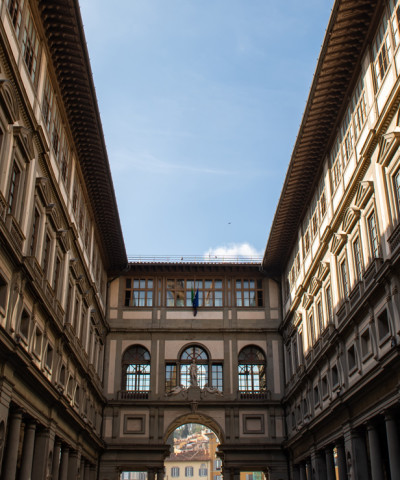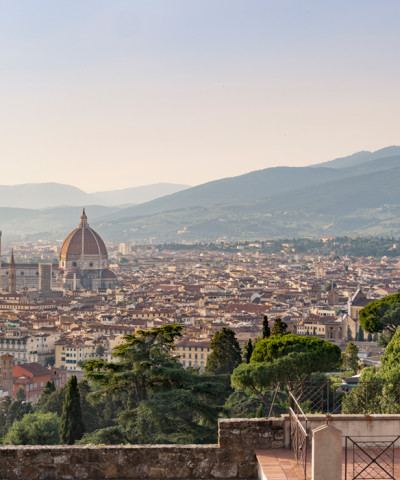Giorgio Vasari narrated by Cristina Acidini
We discover the Arezzo-born genius with the art historian and President of the Academy of Design Arts
450 years after his death, Tuscany celebrates the genius of Giorgio Vasari. We spoke with Cristina Acidini, art historian and President of the Academy of Drawing Arts in Florence, to shed light on this multifaceted and complex figure. Cristina is currently preparing the main exhibition for the celebrations, Il Teatro delle Virtù (The Theatre of Virtues), scheduled to run from 30th October to 2nd February in Arezzo: “I proposed to the organising and scientific committees to present Vasari not only as a painter of the highest rank but also as an intellectual. By focusing on the signs and symbols that fill Vasari’s paintings, which are key to his creativity, we highlight his modernity: he understood the power of logos and invented virtual reality long before us.”
 The great Last Judgement paintedin the interior vault between 1572 and 1579 by Giorgio Vasari and Federico Zuccari(ph. Lorenzo Cotrozzi)
The great Last Judgement paintedin the interior vault between 1572 and 1579 by Giorgio Vasari and Federico Zuccari(ph. Lorenzo Cotrozzi)Vasari’s youth in Florence - what were those years like for Giorgio?
Vasari’s life began as an adventure, marked by travel, thanks to his early talent, his responsible commitment to his family, which was left on his young shoulders after becoming an orphan at sixteen, and some fortuitous encounters. The first was with Cardinal Silvio Passerini from Cortona, who brought him from Arezzo to Florence. There, Vasari met the charismatic figures who shaped his education: Andrea del Sarto, Michelangelo, and other great Florentines. He was also able to integrate himself into the circle of the Medici
What did his encounter with Rosso Fiorentino mean to him?
In his adolescence in Arezzo, as a keen student of Guglielmo Marcillat and a respectful admirer of the elderly Signorelli, Vasari must have experienced meeting Rosso Fiorentino as a revelation. One can only imagine Giorgino’s enthusiasm and reverence for the first great painter he ever met, even though Vasari’s stylistic choices would later take a different direction.
Beyond being an exceptional artist, as someone who has studied him in depth, what kind of man was he?
Vasari’s personality was rich and complex: his correspondence, memoirs, Zibaldone, Vite degli artisti (Lives of the Artists), and Ragionamenti-this vast collection of written documents allows us to glimpse many facets of his subtle and sometimes surprising psychology. He knew how to engage with popes, prelates, and dukes, outwardly accommodating their desires but, in reality, guiding and shaping their projects with skilful suggestions. He feared the envy of his many adversaries - Benvenuto Cellini, for instance, detested him - yet he protected his loved ones and his wealth, while continuously inventing and creating, not just works of art and architecture, but also institutional innovations such as the Academy of Drawing for artists.
 Casa Vasari
Casa VasariWhere did this need for research and documentation on artists’ lives come from?
The spark of this great intuition ignited in Vasari when he was just over thirty, in the company of the scholars and humanists surrounding Cardinal Alessandro Farnese in Rome. Among them were antiquity experts like Orsini, and above all, the historian Monsignor Giovio, who had created a museum of portraits featuring ancient and modern figures. Vasari understood the importance of preserving artists’ biographies and effectively ‘invented’ the history of art as a new historical genre.
Vasari as architect, historian, or painter: which role do you prefer?
It’s so hard to choose! I’ve been reading the Lives since I was a girl, I’ve spent decades working inside the Uffizi, which he designed, and I’ve admired his paintings, even when they were considered rhetorical and repetitive... But the work I’m most attached to is the Last Judgement in the dome of Florence’s Cathedral. At that dizzying height, he painted during the last years of his life, from 1572 to 1574, creating magnificent frescoes, beautifully drawn and with superb colour, on a surface as smooth as silk. Having worked for ten years on the restoration of this immense cycle of paintings, I know them intimately, having caressed them inch by inch.
What architectural work do you find most ingenious?
I could say the Uffizi, with their ‘corridor’ spanning the Arno and reaching Pitti Palace. But I am always in awe of the house Vasari built for himself in Arezzo.
The Chimera will be the star of the Arezzo exhibition, but what is your favourite work by Vasari?
I’m very pleased that the Uffizi Galleries have agreed to lend The Temptations of Saint Jerome from the Palatine Gallery to the Arezzo exhibition. It is a painting that perfectly balances sacred art, inspiring devotion with the elderly penitent saint in the desert, and secular art, evoking sensual suggestions with the beautiful Venus fleeing alongside her banished cupids. As for the Chimera, it is an example of Vasari’s intelligent “use” of a chance find: that magnificent Etruscan bronze, discovered in Arezzo, was sent to Florence to become the symbol of the Etruscan civilisation, the ancestor of modern Tuscany.
















